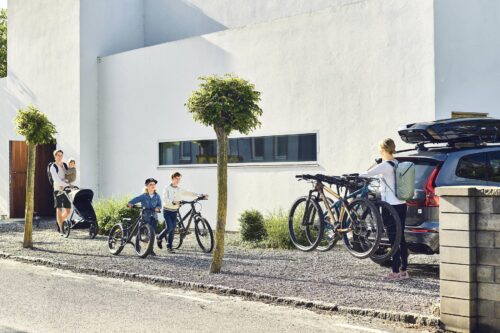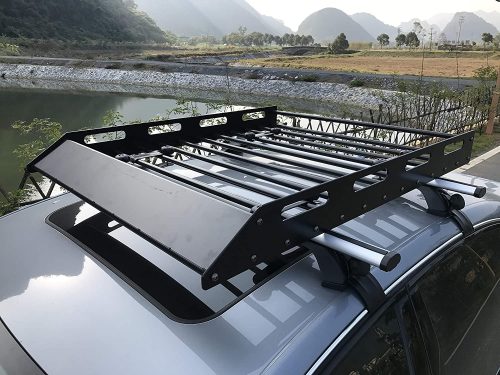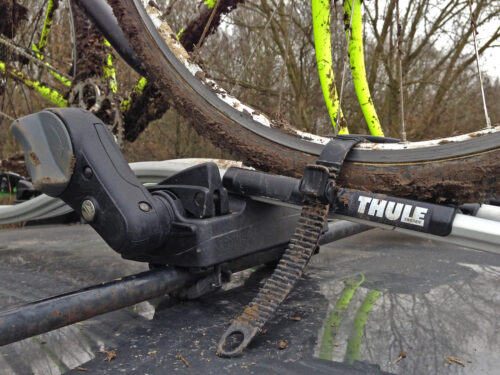What works in the suburbs doesn’t always fly downtown.
Car racks are a game-changer for outdoor gear, bikes, cargo, and family road trips—but if you live in a city, you already know: they can also be a total pain. Low garages, tight parallel parking, unpredictable weather, and limited storage space all raise the stakes. That shiny new roof box or hitch rack might be a perfect solution for weekend escapes—but what about the other 90% of the time?
Here’s how to live with a car rack in the city without giving up your sanity, your security deposit, or your rear bumper.
First: Know What You’re Dealing With
Urban driving is tight. Whether you’re backing into a street spot or creeping through a parking structure with low clearance, vehicle footprint matters.
A few things city drivers run into:
- Roof racks hitting garage beams
- Hitch racks scraping curbs or steep ramps
- Overhanging bikes getting too friendly with other people’s mirrors
- Nowhere to store the rack when it’s not in use
None of this is a dealbreaker—but it is something to plan for.
Parking Garages: Clearance and Confidence
One of the biggest challenges? Vertical clearance.
Most parking garages hover between 6’6″ and 7’2″ (about 198 to 218 cm). That’s fine for a standard vehicle—but add a roof rack, cargo box, or bikes, and you’re suddenly out of luck. Even low-profile crossbars can push a taller SUV into risky territory.
Here’s how to avoid trouble:
- Know your total height with the rack installed—and write it down
- Remove the box or rack between trips if you use garage parking daily
- Avoid rooftop bikes in cities unless you have private parking or an outdoor spot
One alternative? Use a hitch rack instead of a roof system. You lose trunk access and ground clearance, but you’re far less likely to shear it off on a garage beam.
Tight Streets and Parallel Parking
You don’t have to live in Manhattan to feel the squeeze when trying to parallel park with a hitch-mounted rack—or worse, bikes on the back.
Your rear profile is longer than it looks in your mirrors, which makes it easy to bump into fences, poles, or the bumpers of neighboring cars. And racks without tilt or swing-away features can make it a hassle to get into your trunk, especially if they’re loaded. Even when folded up, many hitch racks stick out a good foot or two from the bumper—enough to throw off your parallel parking game.
If you’re parking in tight spots frequently, it’s worth folding the rack every time, even for short stops. Reflective tape can help with visibility if your car is dark or the rack isn’t very obvious. And if you’re parking in high-theft areas, be sure the rack is locked to your vehicle, and consider locking the bikes down even if you’re only stepping away briefly.
Security in the City: Theft and Tampering
Urban areas come with more risk of theft—of both bikes and the racks themselves. It’s not just a bike you have to worry about anymore. People steal racks, too.
Some things you can do:
- Use locking hitch pins to secure the rack to your vehicle
- Remove quick-release parts (like seat bags or wheels) before leaving a bike on the rack
- Add a secondary cable lock through all bike frames and wheels
- Park in well-lit areas and back close to walls or fences to block access
And if you can help it? Don’t leave bikes on the car overnight, especially in the city. Even locked, it’s a gamble.
Storage at Home (Or in the Apartment)
Let’s face it—if you’re living in a third-floor walk-up with zero garage access, storing a full-size rack or roof box indoors is… a challenge.
Wall hooks are your friend. A hanging solution behind a door, along a hallway, or in a closet can save tons of space—especially for folding hitch racks or crossbars. Soft racks and straps can often be rolled and stashed under a bed or inside a storage bin. If you’ve got a shared garage, even a small corner or high shelf can be enough.
Off-season cargo boxes are trickier, but ceiling hoists work surprisingly well. And if you’re limited to indoor storage, just be sure everything is clean and dry before you tuck it away—especially if it’s been through rain or snow.
Bonus tip: keep a small parts kit with your gear. Label bolts, lock cores, and tools in a bag and store them with the rack. It’ll save you time (and frustration) when it’s time to set up again.
Weather and Exposure
City racks tend to live outside. Covered parking is a luxury, and full garages aren’t always an option.
If your rack’s staying on the car:
- Use a rack cover (especially for soft pads or fabric parts)
- Spray key points with silicone lubricant to prevent rust or frozen locks
- Check regularly for corrosion on bolts, clips, and mounting arms
- Tighten everything once a month—vibration from urban potholes and speed bumps loosens parts fast
For bike racks with cradles or clamps, check the rubber for cracking or hardening. City air and constant UV can wear them out sooner than you think.
When to Remove the Rack Entirely
There’s no shame in saying: “I just don’t need this right now.”
If you’re only riding on weekends or taking trips every few months, you might be better off removing the rack between uses—especially if it interferes with daily parking or adds fuel cost from drag.
It’s a 10-minute job, and it:
- Reduces theft risk
- Extends the life of the rack
- Keeps your car easier to drive and park
Just store it properly and keep track of the keys, bolts, and adapters.
Final Thoughts
Car racks are built for adventure—but in the city, they demand a little more strategy. Clearance, security, and day-to-day usability all change when your parking spot is a tight parallel space and your trunk faces an alleyway.
Pick the right rack. Protect it from theft and weather. Remove it when it gets in the way.
And most importantly, make it work for your rhythm—not just the road trip highlight reel.
Willem is an avid mountain biker and outdoor sports enthusiast. For years, he has been riding mountain bike stage races, including the grueling Cape Epic. As a father of three adventurous kids, he knows about packing a vehicle to haul his gear safely and responsibly from home to any exciting weekend or holiday destination.







